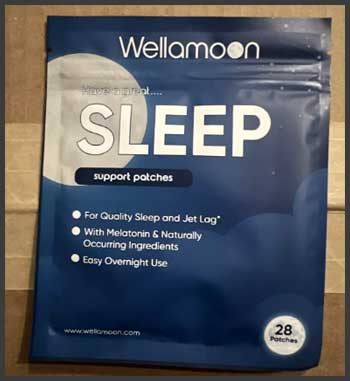When it comes to getting a good night’s sleep, I’m always on the lookout for products that claim to be the ultimate solution. The Wellamoon Sleep Patches caught my attention, promising restful sleep without the dreaded morning grogginess.
I found these patches available on several online platforms like Amazon and the official Wellamoon website. However, I noticed some discrepancies in the reviews, which led me to dig deeper before making a recommendation.
My Experience With Wellamoon Sleep Patches

I’ve tried various sleep aids before, from teas to pills, so the concept of a patch intrigued me.
The patches were easy to apply, and I liked the idea of not having to ingest anything before bed.
However, my experience was somewhat mixed.
While I did notice some improvement in the quality of my sleep, I often woke up feeling slightly groggy, which contradicts the product’s claim of a refreshed morning.
The effectiveness seemed inconsistent, which left me wondering whether this product is truly reliable.
Pros of Wellamoon Sleep Patches
Let’s talk about what I did like:
- Convenience: The patches are incredibly easy to use. You simply peel and stick them on a clean, preferably hairless part of your body before going to bed. There’s no need to remember to take a pill or brew tea, which is a big plus for those of us who value simplicity.
- Natural Ingredients: Wellamoon uses a blend of time-tested ingredients known for their sleep-inducing properties. Valerian Root, Magnesium Malate, Hops, and Melatonin are all included, and these are commonly found in various sleep aids. The fact that these ingredients are slowly released throughout the night is another potential benefit.
- No Morning Drowsiness (In Theory): The product claims to help you wake up refreshed and not groggy. While my experience was mixed, I appreciate the intent behind this feature.
Cons of Wellamoon Sleep Patches
Now, onto the less appealing aspects:

- Inconsistent Results: Despite the promising blend of ingredients, the patches didn’t consistently improve my sleep. Some nights I slept well, while other nights, I didn’t notice much of a difference. This inconsistency was frustrating, especially given the product’s promises.
- Potential for Grogginess: Contrary to the product’s claims, I did experience some grogginess upon waking on several occasions. This could be a dealbreaker for those who can’t afford to start their day feeling less than 100%.
- Cost: While not exorbitant, the patches aren’t cheap. If they worked perfectly, the price might be justified, but with the inconsistent results, I found myself questioning whether they’re worth the investment.
- Mixed Reviews Online: I wasn’t the only one who had mixed feelings about these patches. A glance at customer reviews on various e-commerce sites revealed a significant number of people who were dissatisfied with their purchase, which is something to consider if you’re thinking about trying these out.
Tips For Having Sound Sleep Naturally
Here are some tips to help you achieve natural, restful sleep:
1. Create a Sleep Routine
- Consistency is Key: Go to bed and wake up at the same time every day, even on weekends. This helps regulate your body’s internal clock and makes falling asleep easier.
- Wind Down Before Bed: Establish a relaxing pre-sleep routine, such as reading, taking a warm bath, or practicing deep breathing exercises. This signals your body that it’s time to wind down.
2. Optimize Your Sleep Environment
- Keep It Cool: A bedroom temperature of around 60-67°F (15-19°C) is ideal for most people.
- Darkness Matters: Use blackout curtains or an eye mask to block out light, which can interfere with your sleep.
- Reduce Noise: Use earplugs or a white noise machine if you live in a noisy environment.
3. Watch What You Eat and Drink
- Avoid Caffeine and Nicotine: Both are stimulants that can interfere with your ability to fall asleep. Try to avoid them at least 4-6 hours before bedtime.
- Limit Alcohol: While alcohol might make you feel sleepy, it can disrupt your sleep cycle later in the night.
- Eat Light: Avoid heavy meals before bed. If you’re hungry, a light snack like a banana or a handful of almonds can promote sleep.
4. Stay Active
- Regular Exercise: Physical activity can help you fall asleep faster and enjoy deeper sleep. However, avoid vigorous exercise too close to bedtime as it can be stimulating.
5. Manage Stress and Anxiety
- Practice Relaxation Techniques: Techniques such as meditation, yoga, or deep breathing can help calm your mind and prepare your body for sleep.
- Write It Down: If you find yourself lying awake thinking about your to-do list, try writing down your thoughts before bed to clear your mind.
6. Limit Screen Time Before Bed
- Avoid Electronic Devices: The blue light emitted by phones, tablets, and computers can interfere with your sleep hormones. Try to turn off screens at least an hour before bed.
7. Get Some Sunlight
- Daylight Exposure: Natural sunlight helps regulate your sleep-wake cycle. Try to get outside for at least 30 minutes a day, especially in the morning.
8. Nap Wisely
- Keep It Short: If you nap during the day, limit it to 20-30 minutes. Longer naps can interfere with your nighttime sleep.
- Nap Early: Napping too late in the day can make it harder to fall asleep at night.
9. Use Your Bed for Sleep
- Reserve Your Bed for Sleep and Intimacy: Avoid using your bed for activities like watching TV or working, as this can weaken the mental association between your bed and sleep.
10. Seek Professional Help if Needed
- Consult a Doctor: If you’ve tried these tips and still have trouble sleeping, it may be worth consulting a healthcare professional. They can help identify underlying issues such as sleep apnea or insomnia.
Incorporating these tips into your daily routine can greatly improve your chances of getting the natural, restful sleep your body needs.
How Does Wellamoon Compare To Other Sleep Aids?
There’s no shortage of sleep aids on the market, so how does Wellamoon stack up?
- Wellamoon Vs. Traditional Sleep Pills: One of the main advantages of Wellamoon patches over traditional sleep pills is the mode of delivery. Because the ingredients are absorbed through the skin, they bypass the digestive system, which can reduce the likelihood of stomach upset. However, traditional sleep pills often deliver more consistent results, which is a significant consideration.
- Wellamoon Vs. Herbal Teas: Herbal teas like chamomile or valerian root tea have been used for centuries to promote sleep. While they’re natural and generally safe, they can be inconvenient (who wants to get up in the middle of the night to go to the bathroom?). The patches eliminate this issue but at the cost of potentially less reliable results.
- Wellamoon Vs. Other Sleep Patches: There are other sleep patches available that claim to do the same thing as Wellamoon. Some users have reported better results with alternatives like Klova or PureKana sleep patches, which may be worth exploring if you’re interested in this type of sleep aid.
Also Read: Is Signal Relief Patch Effective?
FAQ: Your Questions Answered
The effectiveness of Wellamoon Sleep Patches seems to vary from person to person. While some users report improved sleep, others find the results to be inconsistent. My personal experience was mixed, with some nights being better than others.
Some users, including myself, have reported feeling groggy in the morning after using the patches. Additionally, there’s always a potential for skin irritation where the patch is applied, especially if you don’t rotate the application site.
Yes, Wellamoon Sleep Patches contain melatonin, a hormone that helps regulate sleep-wake cycles. It’s one of the key ingredients in the patches, along with Valerian Root, Magnesium Malate, and Hops.
You can apply the patch to any clean, dry, and preferably hairless part of your body. Common areas include the upper arm, shoulder, or lower back. Just be sure to rotate the application site to avoid skin irritation.
Conclusion: A Patch That’s Not Quite Perfect
In conclusion, while Wellamoon Sleep Patches offer a convenient and natural approach to improving sleep, they’re not without their flaws. The inconsistent results and potential for morning grogginess make it difficult for me to fully recommend them.
If you’re curious and want to try them out, I’d suggest purchasing from a retailer with a good return policy, just in case they don’t work out for you. However, based on my experience and the mixed reviews online, you might want to explore other sleep aids before settling on Wellamoon.
Remember, sleep is crucial, and it’s worth finding the right solution that truly works for you.




I do like these patches. HOWEVER the seller changed the construct. The last order (from early October 2024) was a thicker patch and literally oozed with the adhesive. Hurt like dickens when trying to remove the patch in the morning PLUS it left a sticky residue on skin and night clothes. I immediately wrote to seller. Got no response. Tried another night and put patch in less tender place on arm. This time the sticky got onto sheet and pillow and I had to strip them off to launder them plus the nightgown from where my arm moved around during the night. The seller refuses to replace or refund because I did not complain within 30 days of my purchase. If I recall, the product did not even arrive until about 3 weeks after purchase. SO, a negative from me!
I agree. I HATE The changed patches. Almost takes your skin off when you try to remove it in the morning.
I purchased one package to try it but somehow four packages got added to my order and I was charged another $40. I’ve been trying to get my money back and I have nothing but problems with them. And their patches really don’t work so a waste of my time and money.don’t buy them
Scammers
Yes, first time I ordered it tricked me into getting 2 orders. But I was satisfied with the patches. 2nd time they did the same thing and the patches are different and they are thicker and about take my skin off when I remove them. Hate the new ones. I’m sure I’m stuck with them.